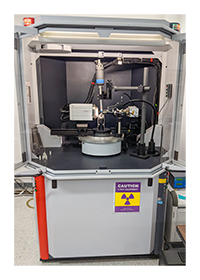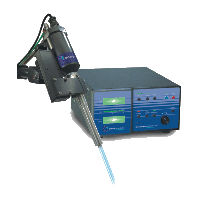Crystallographic Facilities @ Otterbein
The Department of Chemistry at Otterbein University has extensive equipment for the study of materials by X-ray diffraction, including both single-crystal and powder diffraction instrumentation. These are used by students in a variety of classes, including Inorganic Chemistry (CHEM 3200/3210), Structural Methods in Chemistry and Biochemistry (CHEM 4100) and undergraduate research.
If you are a faculty member at a primarily undergraduate institution (PUI) and would like to collect X-ray data on your samples, please contact me.

Bruker D8 / SMART APEX II Diffractometer
The Bruker APEX II diffractometer was purchased as part of an NSF-supported grant project (CCLI #0942850) to incorporate experimental structural chemistry into the undergraduate curriculum. The system includes a conventional sealed-tube molybdenum X-ray source (λ = 0.71073Å) and a cooled APEX II CCD detector. The instrument has been used in General Chemistry, Inorganic Chemistry, Intro to Crystallography, Structural Methods and to support undergraduate research. Some example structures determined as part of student projects or research are posted in the Structure Gallery.

Oxford Cryosystems Cryostream 700
The Oxford Cryosystems Cryostream system allows collection of diffraction data down to 90K using liquid nitrogen as a coolant. Collecting at low temperature helps stabilize sensitive samples and improves data quality. We have used this variable-temperature capability to investigate the solid-solid phase transition in certain metal halide cluster salts (see Johnston, D.H.; Brown, C. M.; Yu, A. S.; Gallucci, J. C. “A low-temperature phase of bis(tetrabutylammonium) octa-μ3-chlorido-hexachlorido-octahedro-hexatungstate”, Acta Cryst. 2010, C66, m303-306). We have also determined the structure of a number ionic liquids and how their conformations change with temperature (Johnston, D.H.; Gasbarre, M.; Norris, C.E. “Structural and conformational analysis of 1-butyl-3-methylimidazolium nitrate”, manuscript in preparation).

Meiji EMZ-5TRD Zoom Stereo Microscope with Polarizer
The polarizing microscope is used for inspection and mounting of crystal samples. It has an attached Jenoptik digital camera to display and capture images of samples.
A µCHILL apparatus (Solar, M.; Trapp, N. µCHILL: A Lightweight,
Modular System for Handling Crystalline Samples at Low Temperatures under Inert
Conditions. J. Appl. Crystallogr., 2018, 51, 541–548. https://doi.org/10/gdcp2k)
is available for handling sensitive or low-melting samples.

Rigaku Miniflex II Powder Diffraction System
The Rigaku Miniflex provides an additional tool for the characterization of organic and inorganic materials. We have used this instrument in our General Chemistry laboratory (characterization of sol-gel embedded gold nanoparticles), Inorganic Chemistry laboratory (synthesis of a superconductor, preparation of chromium and cobalt spinels) and for undergraduate research. Match! software from Crystal Impact is used for phase analysis of powder data obtained using the Miniflex II.

CSD - Enterprise (campus license)
Otterbein University has a full campus license to the Cambridge Structural Database (CSD), allowing searching and analysis of the over 1.1 million entries in the CSD. The CSD and associated programs are used in General Chemistry, Inorganic Chemistry, Intro to Cheminformatics and Structural Methods.